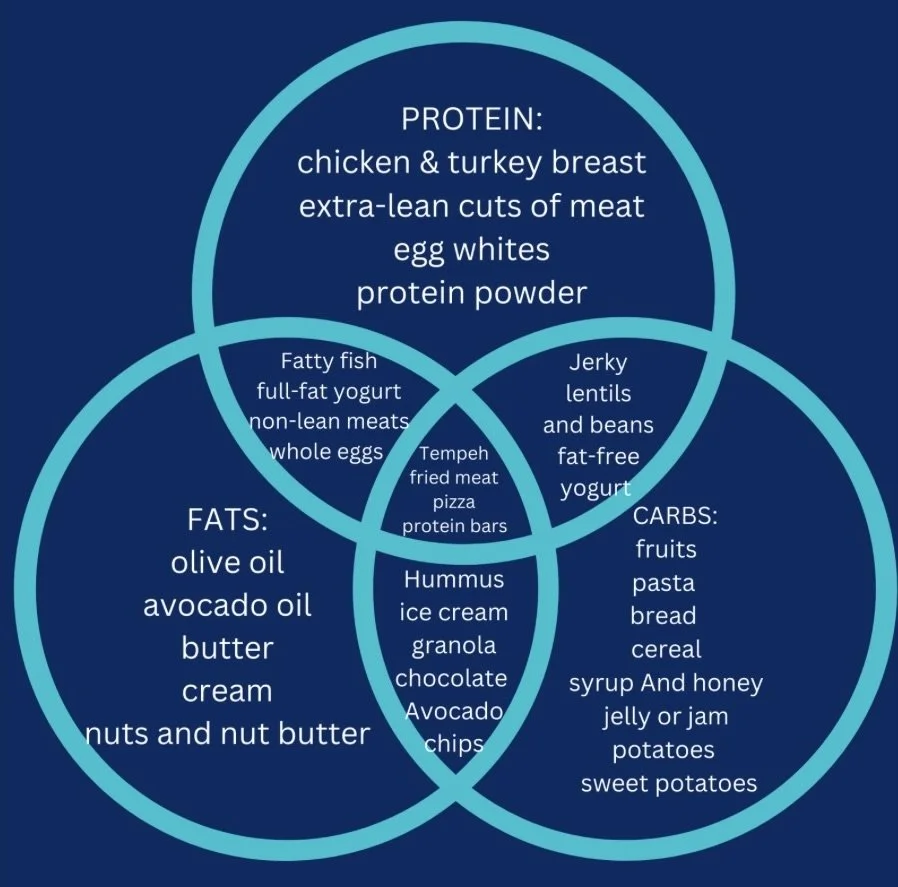What are Macros and How Do I Track Them?
You may have overheard a gym bro talking about hitting his “macros” or how he managed to “crush a pint of ice cream and still hit his numbers”, so let’s talk about what macros are and how to hit them. Ice cream optional but the entire pint is excessive in most cases.
Macros is short for macronutrients, the big three categories of nutrients that food falls into: carbohydrates, fats, and proteins. Each macro plays an important role in our daily functions, for example, fats are beneficial for hormone production, long-term energy, reproductive health, and vitamin absorption. It is the most calorically dense macronutrient at 9 calories per gram so we want to keep it in check to avoid overconsumming calories. Some healthy fat options include olive oil, avocados and avocado oil, grass-fed butter and cheese, nuts and nut butter, as well as seeds.
This is a chart of what food falls into which category. Notice some foods cross over and can do double duty.
Carbohydrates are our body’s preferred source of energy. They also help with glucose control because when you eat them, insulin is released to shuttle the broken-down carbohydrates (glucose) into the cells, causing blood sugar to drop. When paired with fats and protein, this drop is less aggressive so your energy levels stay consistent throughout the day. Carbohydrates have 4 calories per gram, almost half as many calories as fat, which is why we can typically eat more carbohydrates in our macros. Healthy carbs include rice, rolled oats, regular and sweet potatoes, fruit, legumes, and vegetables.
Protein is our building macronutrient. It helps build and maintain muscle and acts as a messenger between our cells, tissues, and organs. Like carbohydrates, protein contains 4 calories per gram but has a slight thermogenic effect so you burn slightly more calories when you consume protein as opposed to the other macros. Healthy protein sources include lean poultry, ground beef, fish, tofu, tempeh, Greek yogurt or Skyr, and protein powder (read the labels and look for fewer ingredients when possible).
So how do we track these? There are a couple of methods I use with my clients: weighing and measuring or hand portioning. Weighing and measuring involves a food scale and can be a bit more time-consuming than hand portioning. I like this method for beginners or people who want to be really dialed in for an event. Once you have your macros, I recommend dividing them by the number of meals and snacks you have in a day. This prevents you from having weird numbers to fill at the end of the night.
When you’re weighing your food, the weight on the scale is the volume of food, not the amount of macros you’re getting from it. For example, a chicken breast weighed out is 5 ounces, but you’re getting 32 grams of protein from that chicken breast. Make sense? Once you’ve weighed your food, you log it in an app such as MyFitnessPal or another app of you’re choosing. Your goal is to hit your target numbers or be within 5-7 grams of your target number each day. This takes practice so be patient with yourself.
The hand portion trick is my favorite for traveling or nights out because bringing your food scale to a restaurant is awkward. I’ve lived the experience for you so you don’t have to. For this trick, you’ll split your macros into hand portions and then track them however you like. I like to use my notes section on my phone and give myself a certain number of emojis for each macro and I’ll erase them as I eat throughout the day. This method is almost as accurate as weighing and measuring plus it’s tailored to you because it’s your hand size. It can also be good for people who get too obsessive with the food scale to take a break without completely giving up on macros.
So what’s next? If you’re ready for 1:1 nutrition coaching, fill out this form and I’ll be in touch!
Not ready to commit to a coach? Check out my FREE macro calculation guide! This is a great jumping off point and you can always book a nutrition power hour call with me to check on your macro numbers!


